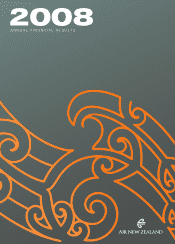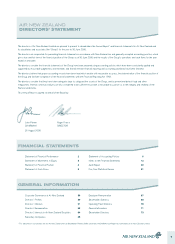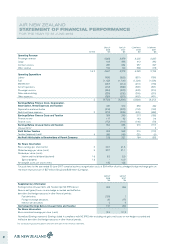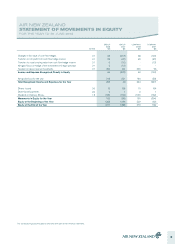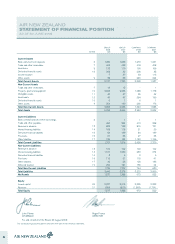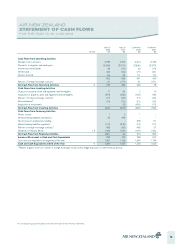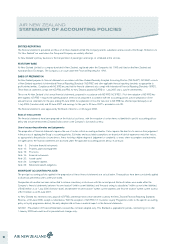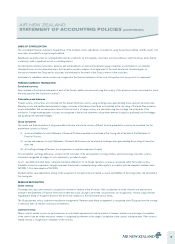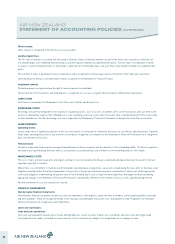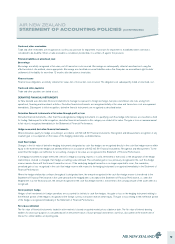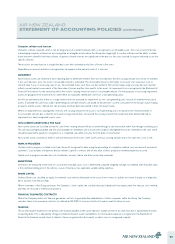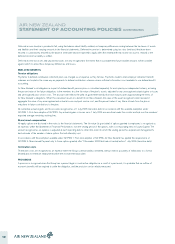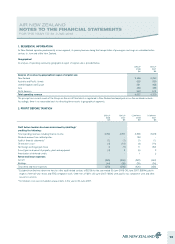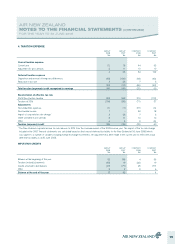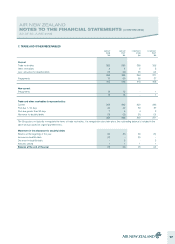Air New Zealand 2008 Annual Report Download - page 9
Download and view the complete annual report
Please find page 9 of the 2008 Air New Zealand annual report below. You can navigate through the pages in the report by either clicking on the pages listed below, or by using the keyword search tool below to find specific information within the annual report.
AIR NEW ZEALAND
STATEMENT OF ACCOUNTING POLICIES (CONTINUED)
BASIS OF CONSOLIDATION
The consolidated financial statements include those of the Company and its subsidiaries, accounted for using the purchase method, and the results of its
associates, accounted for using the equity method.
Subsidiaries are entities that are controlled either directly or indirectly, by the Company. Associates are those entities in which the Group, either directly
or indirectly, holds a significant but not a controlling interest.
All material intercompany transactions, balances and unrealised gains on transactions between group companies are eliminated on consolidation.
Unrealised losses are also eliminated unless the transaction provides evidence of an impairment of the asset transferred. Unrealised gains on
transactions between the Group and its associates are eliminated to the extent of the Group’s interest in the associates.
Investments in subsidiaries and associates are recognised in the financial statements at their cost of acquisition less any provision for impairment.
FOREIGN CURRENCY TRANSLATION
Functional currency
Items included in the financial statements of each of the Group’s entities are measured using the currency of the primary economic environment in which
the entity operates (the “functional currency”).
Transactions and balances
Foreign currency transactions are converted into the relevant functional currency using exchange rates approximating those ruling at transaction date.
Monetary assets and liabilities denominated in foreign currencies at the balance sheet date are translated at the rate ruling at that date. Non-monetary
assets and liabilities that are measured in terms of historical cost in a foreign currency are translated using the exchange rate at the date of the
transaction. Foreign exchange gains or losses are recognised in the income statement, except when deferred in equity as qualifying cash flow hedges
and qualifying net investment hedges.
Group companies
The results and financial position of all group entities that have a functional currency different from the presentation currency are translated into the
presentation currency as follows:
(i) assets and liabilities for each Statement of Financial Position presented are translated at the closing rate at the date of that Statement of
Financial Position;
(ii) income and expenses for each Statement of Financial Performance are translated at exchange rates approximating those ruling at transaction
date; and
(iii) all resulting exchange differences are recognised as a separate component of equity.
On consolidation, exchange differences arising from the translation of the net investment in foreign entities, and of borrowings and other currency
instruments designated as hedges of such investments, are taken to equity.
As at 1 July 2006 (transition date), cumulative translation differences for all foreign operations, previously recognised within the foreign currency
translation reserve (a component of equity) have been transferred to retained earnings within equity in accordance with the exemption available under
NZ IFRS 1: First-time adoption of NZ IFRS.
Goodwill and fair value adjustments arising on the acquisition of a foreign entity are treated as assets and liabilities of the foreign entity and translated at
the closing rate.
REVENUE RECOGNITION
Airline revenue
Passenger and cargo sales revenue is recognised in revenue in advance at the fair value of the consideration received. Amounts are transferred to
revenue in the Statement of Financial Performance when the actual carriage is performed. Unused tickets are recognised as revenue using estimates
regarding the timing of recognition based on the terms and conditions of the ticket and historical trends.
The Group operates various codeshare and alliance arrangements. Revenue under these arrangements is recognised when Group performs the carriage
or otherwise fulfils all relevant contractual commitments.
Contract revenue
Where contract related services are performed over a contractually agreed period, and the amount of revenue, related costs and stage of completion
of the contract can be reliably measured, revenue is recognised by reference to the stage of completion of the contract at balance date. Other contract
related revenue is recognised on completion of the contract.
7

